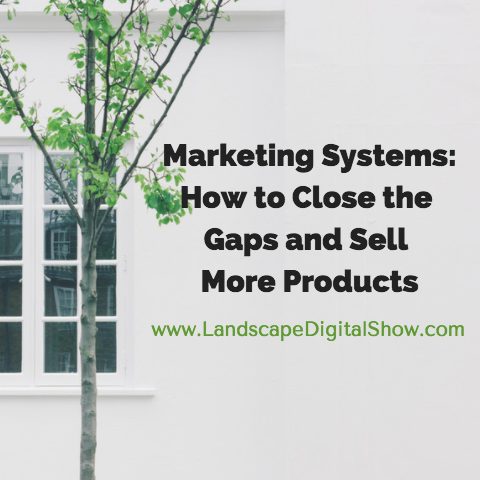Episode 76 of Landscape Digital Show reveals how to sell more products by finding and closing gaps in your marketing systems.

When you approach marketing as a system everything gets easier because it gives you a basis for evaluating possibilities, such as what to leave in and what to leave out.
Choices have to be made and less is usually more. Less complexity leads to more predictable results. Although, some risk is inherently involved to keep the company competitive and growing.
One of the risks for companies that learned to succeed with traditional marketing and selling systems is being relevant for digital savvy consumers. However, regardless of the methods used, everything still comes down to a simple three part formula:
#1. Get people’s attention
#2. Interact with people
#3. Sell products that add value to people’s lives
If there are any gaps in that equation business growth is compromised. All marketing systems must balance attraction with engagement, and they must seamlessly integrate with selling systems that bring home the profits that sustain the company and its growth.
#1. Get People’s Attention
Advertising is how businesses have traditionally introduced or reminded people about them and the products they sell. Now social media is the new advertising, and that’s certainly how many companies try to use it.
However, anyone that has tried to use social media for product awareness understands it’s a different animal than advertising. Not only do you have to choose from the many social media channels, but also how to use them well. You must have a strategy that goes beyond basic awareness because that’s not nearly enough anymore.
Your strategy to get attention might include humor, entertainment, education, news, or humanity. The trick is deciding on the story you want to tell and making choices about how to use one or several channels to consistently do that.
Whether the media is free or carries a price-tag, the true cost is what it takes to get people’s attention. If you cannot accomplish that then your business will always be challenged with lead generation. Study what works for others, then test those methods and track your results to discover what works for you.
#2. Interact with People
Interaction is a two-way street, and that is why it’s best to get permission to do so. Fortunately, social media typically takes care of this for you by managing friend requests and the like.
Although, more powerful than social media for interaction is email because it is targeted and gives you greater control. However, as a business, you still have to get people’s permission to send them emails. That’s why we call email marketing permission marketing.
Recommended for You
Webcast, September 7th: Growth Hacking: Everything that is Working Right Now (Brand New Hacks)
The flip side of email marketing is that people will unsubscribe if the interaction does not give them the value they had hoped for. Thus, if your list is not growing you need to change your approach.
As long as that list is growing you shouldn’t worry about unsubscribes. You only want people on your list that want to receive communications from you, because if they are not, the likelihood of them buying is almost zero.
You may find it useful to occasionally create a Facebook custom audience of your unsubscribes and target them with a special offer. You may be surprised at how many accept it and rejoin your list. This is just one example of using marketing systems to add value instead of just promoting.
#3. Sell Products that Add Value to People’s Lives
To sell products on or offline you need a system that you can recite in your sleep, step by step. In fact, if you believe as I do that everyone in your company is in selling then they too should know this system cold.
You never know if the opportunity to sell will happen at a neighborhood block party or waiting in line at the local Chamber of Commerce event. This is why everyone in your company is in selling, and why they should know the constants and variables of your selling system.
Constants are the non-negotiables that allow your company to deliver an exceptional customer experience. This may include when and where you meet, what gets discussed, and the resources used, such as how to communicate payment terms.
Variables are how the business adapts and personalizes its products and experiences for the buyer, including budgets, timelines, and style choices. Ideally, this should be a collaboration that makes the customer feel safe and confident in their future with you.
Lastly, every selling system should accommodate specific exceptions that I refer to as catalysts. This is when a buyer wants to take a shortcut to product ownership. It may go something like this: “Look, not to be rude, but I trust you and would just like to move ahead now. Can we do that?”
If you are comfortable that what needed to be communicated has been, or will be before the work begins, then accommodate their wishes.
Marketing systems are typically designed to close gaps by removing obstacles that prevent buyers from moving ahead. But there should also be some flexibility in them to accommodate a more experienced or prepared buyer.
Call to Action
The call to action for this episode is to revisit your systems for getting people’s attention and selling them products that will add value to their lives.
In other words, revisit how your company fulfills its mission.
